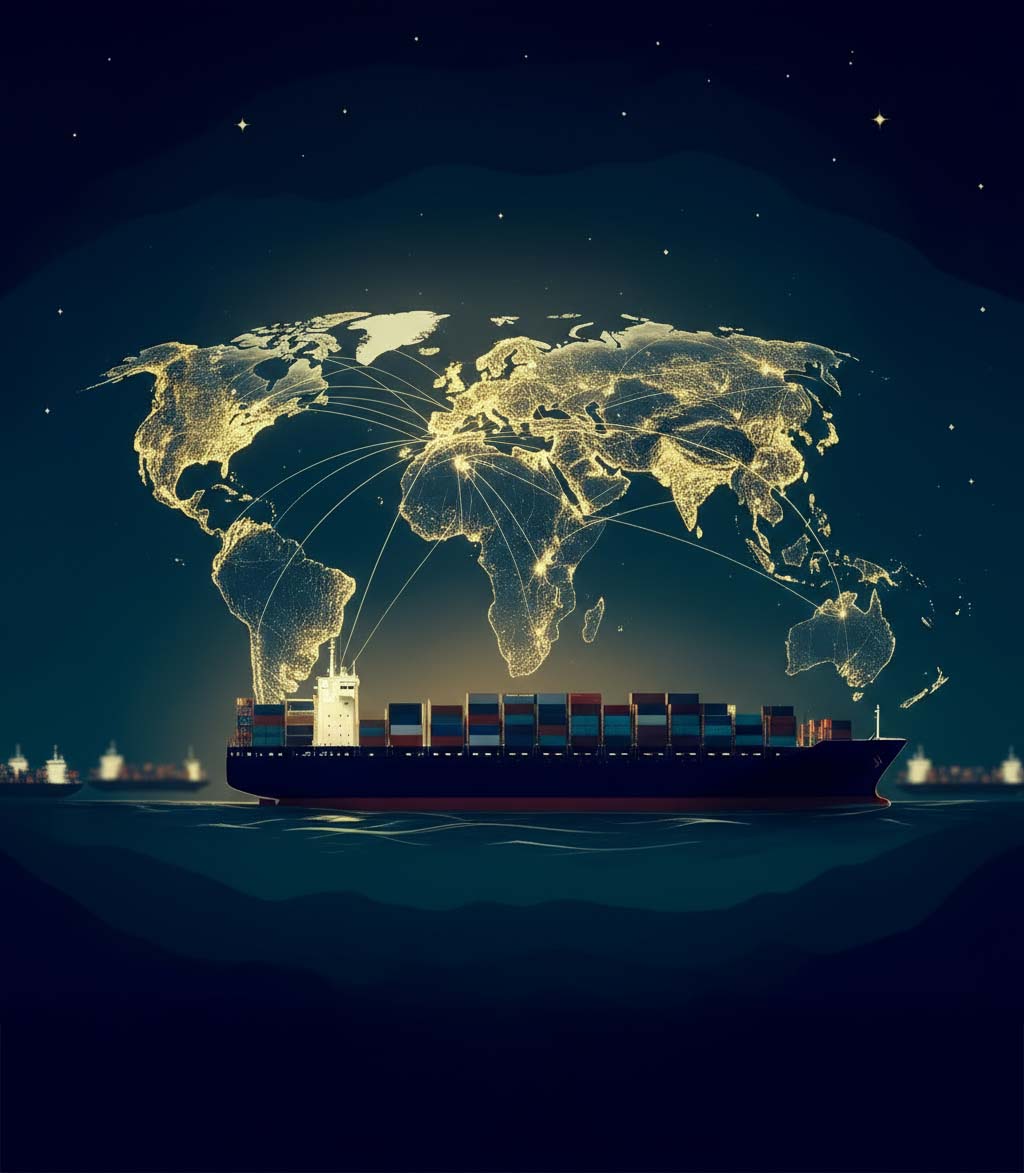From Overhead to Opportunity: The Pragmatic Guide to an AI-Driven Supply Chain

Global supply chains are currently navigating a period of unprecedented turbulence. The convergence of rising customer expectations, geopolitical instability, economic uncertainty, and climate volatility is exposing the limitations of traditional supply chain management. Manual processes, siloed data, and static systems are no longer sufficient to handle the speed and scale of today’s disruptions.
At the same time, artificial intelligence (AI) has come to be more than just an enhancement — it represents a fundamental paradigm shift. By unifying data from ERP systems, external market feeds, and IoT devices, AI enables real-time, predictive, and prescriptive decision-making that is reshaping the way organizations plan, source, produce, and deliver.
This evolution transforms supply chains from reactive, brittle structures into adaptive, intelligent ecosystems that drive profitability, resilience, and sustainable growth. The following analysis explores the challenges that demand change, the AI-powered technologies enabling transformation, and the tangible returns that demonstrate AI’s value within supply chains.
Global supply chain challenges: A current impact assessment
The global landscape is forcing a re-evaluation of traditional supply chain strategies. The following challenges underscore the need for a more intelligent and adaptive approach:
- Rising customer expectations: The “Amazon effect” has made rapid, low-cost shipping the new normal. This demand for speed, coupled with post-COVID supply chain fissures, has forced organizations to pursue dual-sourcing and regionalization to balance cost efficiency against service expectations.
- Geopolitical instability and trade shifts: Ongoing conflicts, such as those in Ukraine and the Middle East, have forced the rerouting of shipments around the Horn of Africa. In addition, regional supply chains are increasingly important to global trade as part of a shift toward localized and resilient networks.
- Shortages of raw goods: The scarcity and limited availability of critical raw materials pose a growing threat. This is not just a problem of logistics but of resource vulnerability. For example, the semiconductor industry has faced a prolonged chip shortage, impacting everything from automotive to consumer electronics manufacturing. Similarly, disruptions to the supply of essential minerals, agricultural goods like wheat, or even packaging materials like cardboard can cause production lines to grind to a halt. These shortages are driven by a combination of factors, including concentrated geographic sourcing, extreme weather events, and a mismatch between surging demand and constrained production capacity.
- Extreme weather and climate impact: Climate-driven disruptions are increasing in both frequency and intensity. Canadian wildfires in 2024, for example, delayed shipments and reduced throughput by up to 75% in some areas. Companies are facing more moderate-to-severe climate-related disruptions, and the impact is expected to grow as some anticipate that the number of climate-related disasters could be as much as 40% higher in 2030 when compared to 2015.
- Economic volatility, tariffs, and reverse tariffs: Supply chains are under constant strain from economic shifts, with freight rates remaining volatile and inflation pressuring margins. The enduring effects of tariffs and retaliatory measures are layered upon this volatility. U.S. Section 301 tariffs, along with countermeasures from China and the EU, have raised landed costs for raw materials and finished goods, particularly in medical devices, pharmaceuticals, and semiconductors. Meanwhile, reverse tariffs — duties imposed on exports from tariff-imposing nations — add further strain. These dynamics are accelerating regionalization and near-shoring as firms hedge against “tariff whiplash.”
Within this dynamic environment, traditional supply chain tools are struggling to keep pace. Many leaders struggle with operational challenges and a lack of supplier visibility. In addition, advanced planning systems often underperform, and organizations struggle with slow responses to disruption, which can impact weekly sales and operations execution (S&OE) cycles.
AI is essential in navigating this complexity and solving the challenges traditional tools present. For example, digital twins can simulate tariff scenarios across trade lanes, while machine learning identifies optimal sourcing alternatives. Real-time monitoring of regulatory feeds allows companies to dynamically calculate landed costs and proactively adjust procurement and distribution strategies. Amid a dynamic global supply chain environment, the new opportunities AI provides are critical for companies looking to stay ahead of the curve.
Understanding the technology: AI in practice
AI transforms supply chain management from end to end by addressing the core challenge of data fragmentation and enabling advanced analytics. The following technologies illustrate the practical impact AI can have on supply chains:
- Master data management and consolidated data: Provides the foundation for an intelligent supply chain through a unified data model. AI first requires the consolidation of data from disparate technology platforms — including enterprise resource planning (ERP) systems, warehouse management systems (WMS), procurement, transportation management systems (TMS), and production planning. By creating a single source of truth for clean, harmonized supply chain data, AI can generate accurate insights.
- Machine learning (ML): Identifies hidden patterns across massive datasets to create highly accurate demand forecasts, optimize inventory levels, and predict equipment failures.
- Predictive analytics: Anticipates demand surges, supply constraints, and equipment failures before they occur, allowing for proactive, rather than reactive, decision-making.
- Agentic AI: Executes autonomous actions based on real-time data, such as automatically rerouting shipments to avoid delays or updating production schedules in response to a material shortage.
- Digital twins: Create a virtual, real-time replica of the physical supply chain network and its assets. This allows for the simulation of “what-if” disruption scenarios, enabling companies to stress-test strategies for raw material shortages, port closures, or new tariff policies.
Together, these capabilities allow supply chains to shift from static and reactive to dynamic and proactive. By embedding intelligence into everyday operations, AI transforms complexity into clarity and prepares organizations to realize value from supply chain improvements.
The business payoff: How AI adds value
The promise of AI is not confined to theory; its real power lies in the measurable gains it brings across every element of the supply chain. As technology matures, organizations are discovering how deeply AI can embed itself into the flow of operations — reducing inefficiencies, unlocking productivity, and enabling new levels of optimization.
AI delivers value across every function of the supply chain:
- Procurement and sourcing: AI can optimize sourcing in terms of cost, risk, ESG, and reliability, with real-time monitoring of global feeds for disruption signals.
- Manufacturing and production: AI can power predictive maintenance to minimize downtime and continuously optimize production schedules.
- Logistics and transportation: AI can reroute supply chains in real time and fuel autonomous replanning to reduce delays and improve reliability.
- Warehousing and inventory: AI can automate replenishment, optimize layouts, and increase throughput with robotics.
- Risk and compliance: AI can simulate tariffs, track ESG metrics, and monitor compliance to enhance resilience and regulatory adherence.
These functional gains translate into enterprise-level returns that are both immediate and compounding over time.
In addition, the following areas highlight the quantifiable ROI that companies are achieving through AI-enabled supply chain initiatives:
- Margin expansion: Smarter inventory optimization reduces overstocking and stockouts, while AI-driven dynamic freight routing can reduce fuel costs by up to 25%. Predictive maintenance further cuts unplanned downtime costs.
- Revenue growth: AI can significantly improve forecast accuracy, ensuring products are available when and where customers need them. Fulfillment processing gains of up to 30% can also contribute to strengthened customer loyalty and new revenue streams through enhanced service levels.
- Resilience and foresight: Continuous monitoring of global risk signals — from tariffs and weather to geopolitical unrest and raw material availability — and digital twin simulations enable organizations to stress-test strategies and proactively manage disruptions.
- Compliance and sustainability: AI tracks shifting regulatory requirements, tariff exposures, and ESG commitments in real time. This reduces compliance costs, avoids penalties, and strengthens brand reputation while enabling measurable progress toward sustainability goals.
- Innovation and agility: By automating routine decision-making, AI frees teams to focus on innovation. Organizations can experiment with new operating models, diversify sourcing, and scale advanced capabilities like robotics and autonomous logistics, turning adaptability into a competitive differentiator.
AI at work: The real-world impact
Leading organizations across diverse industries are already demonstrating a significant return on investment from AI.
For example, I recently worked with a global pharmaceutical company that operated a decentralized, fragmented supply chain with minimal central oversight. This structure created blind spots, prevented the capture of operational efficiencies, and left them unable to evaluate manufacturing models like nearshore, offshore, or onshore. As a result of this setup, the business was exposed to significant risks, including unpredictable costs from tariff volatility and multi-million-dollar fines from compliance errors. Without a centralized, data-driven framework, leadership lacked the visibility to effectively manage these threats.
To address these challenges, I assisted in the design, deployment, and change management of a data-driven, AI-powered supply chain control tower built on digital twin technology to deliver real-time visibility across global operations. The platform integrated:
- Tariff simulation models to forecast landed costs
- Supplier risk scoring to assess financial and geopolitical exposure
- Logistics optimization to streamline transport routes and reduce freight costs
The digital twin enabled leadership to evaluate and deploy nearshore, offshore, and onshore manufacturing strategies, optimizing for both cost savings and resilience. The system not only mitigated risks but also proactively identified cost-saving opportunities.
This AI-powered supply chain initiative delivered immediate, measurable impact, including:
- Establishment of a globally integrated, data-driven supply chain that eliminated data silos
- A diversified logistics and delivery warehouse model that reduced delivery costs by 35%
- $25M in annual tariff savings
- A 45% increase in manufacturing efficiencies, translating to an estimated $75M EBITDA improvement
- A 40% decrease in supply risk exposure
The scalable control tower provided the foundation to seamlessly integrate newly acquired businesses, accelerating post-acquisition value creation. Enhanced visibility also improved the Sales & Operations Planning (S&OP) process, ensuring supply capacity aligned with demand to maximize global sales. This initiative serves as a clear example of the impact AI can make for supply chains and the measurable benefits an AI-powered supply chain can deliver.
How executives can take action
The case for AI in supply chains is urgent and compelling. Executives must lead the charge by setting a clear vision, mobilizing cross-functional teams, and investing strategically in data foundations.
If you’re unsure where to start, taking these immediate steps can help set up your organization for success:
- Champion change from the top: Elevate supply chain resilience and AI adoption to a board-level priority.
- Form a cross-functional AI task force: Engage IT, supply chain, finance, and compliance leaders.
- Invest in data foundations: Build a strong foundation of unified, clean data that can be used to power AI.
- Pilot for quick wins: Prioritize high-impact use cases that deliver measurable ROI within 90 days.
- Scale with governance: Use explainable AI, establish oversight frameworks, and ensure compliance readiness.
- Embed AI in strategic planning: Leverage AI-driven risk models and digital twins in capital allocation, sourcing, and resilience planning.
- Develop talent and culture: Train teams to work with AI tools and reward data-driven decision-making.
Beyond these near-term actions, executives must take a longer view. AI cannot remain a side “innovation project.” It must instead become a core operating model, embedded into the company’s primary operations. Resilience and adaptability — key benefits of AI-enabled supply chain strategies — should be treated as competitive differentiators, with the supply chain positioned not as a fragile cost center but as a profit engine and a strategic driver of growth.
Building a future-ready supply chain
Artificial intelligence is fundamentally redefining supply chain management. It provides predictive foresight, autonomous execution, and dynamic adaptation — capabilities that traditional tools cannot match. The old model of reactive, siloed processes is simply not equipped to handle the volatility of the modern world.
Organizations that act decisively will not only reduce costs and mitigate risk but also build a new kind of resilience, secure a durable competitive edge, and transform their supply chain from a point of vulnerability into a strategic driver of growth and market leadership. The future of supply chains is AI-powered, adaptive, and intelligent. The question for executives is no longer if they will embrace AI, but how quickly they will get started.
Yet successfully navigating this transformation requires more than technology — it requires experience, foresight, and proven execution. Partnering with Experts who have led large-scale AI supply chain initiatives can accelerate adoption, avoid costly missteps, and deliver faster ROI.
Start building a smarter, more resilient supply chain.
Get in TouchMeet the Author
J. Gregory “Greg” Smith is a Catalant Expert and Digital Supply Chain Consulting Practice Leader at Digital-SCM LLC, a boutique supply chain consulting firm. With 25 years of global experience, Greg has delivered measurable, transformative results for organizations across a variety of industries, consistently driving cost savings, EBITDA improvements, and operational resilience. His career includes senior leadership roles at prestigious consulting and technology firms such as Deloitte, Gartner (Meta Group), IBM Global Business Services, and others. He holds a Bachelor of Business Administration in Finance from the University of Massachusetts.
Related Articles
Share Article










